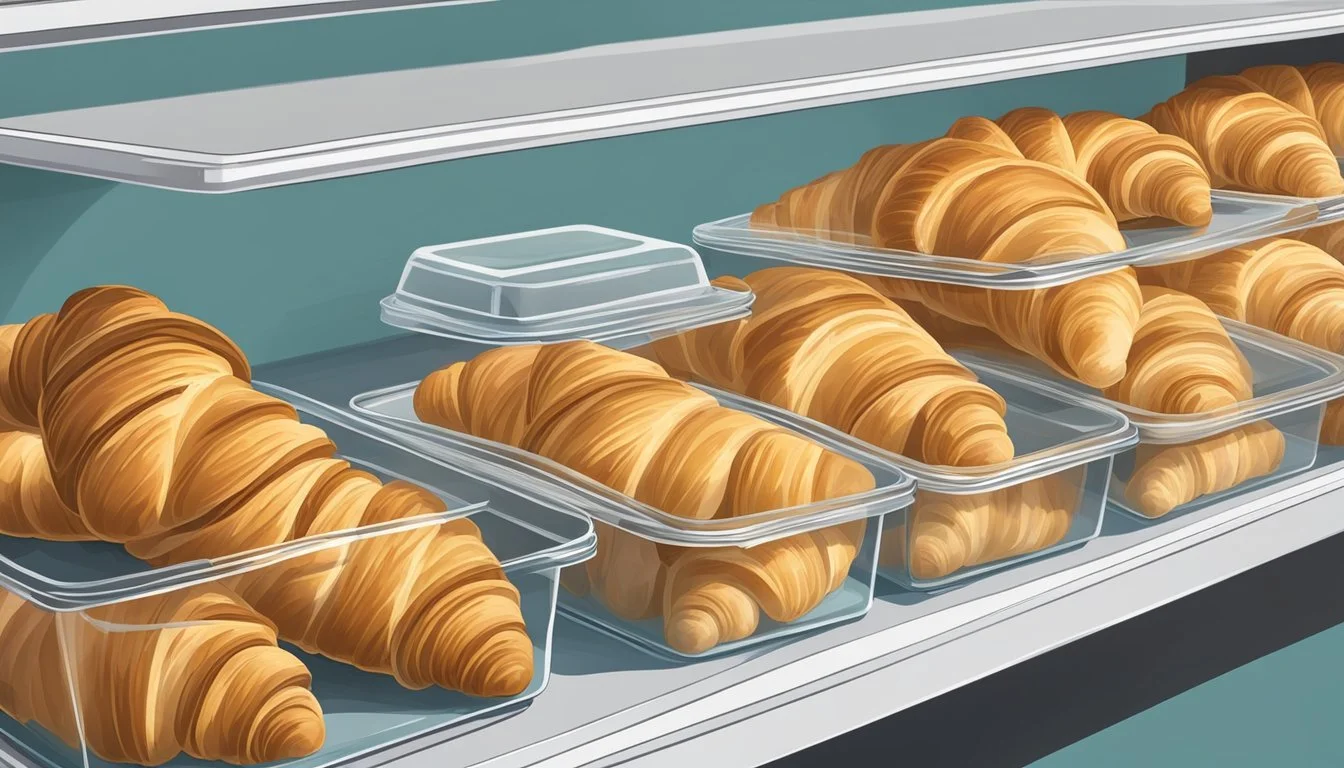How Long Do Croissants Last?
Shelf Life and Storage Tips
Croissants (how long do croissants last?), with their flaky layers and buttery flavor, are a staple of French baking relished all around the world. These pastries are best enjoyed fresh, but often, one may find themselves with more croissants than can be consumed in a single sitting. The shelf life of a croissant is not particularly long due to its delicate structure and high butter content, which makes them prone to staleness.
At room temperature, croissants generally maintain their quality for about 1 to 2 days when stored properly in a paper bag or bread box to balance humidity and airflow. If extended preservation is necessary, refrigeration can prolong their freshness up to 5 days. In both cases, ensuring that they are wrapped to prevent drying out and to retain their texture is crucial.
For those looking to keep croissants beyond a few days, freezing emerges as a practical solution. When properly wrapped to prevent freezer burn and moisture loss, croissants can be frozen for 1 to 2 months without a significant decrease in quality. It should be noted that while freezing can extend the croissant's edibility, the optimal sensory qualities of texture and flavor are best preserved by enjoying them as fresh as possible.
Understanding Croissants
To appreciate the longevity of croissants, it's imperative to understand their origins, key components, and the differences between freshly baked and packaged varieties.
History of Croissants
The croissant is renowned as a staple of French bakeries but traces its origins back to 17th century Austria. Its iconic crescent shape was crafted to celebrate the defeat of the Ottoman Turks by bakers who served the victorious forces, thus capturing the symbol of the Ottoman flag. The pastry became popular in France when introduced by Marie Antoinette.
Croissant Ingredients
Croissants hinge on a simple yet precise blend of ingredients:
Flour: The foundation of the dough.
Water: To hydrate and bring the dough together.
Yeast: For fermentation and giving rise to the dough.
Sugar: To provide sweetness and assist in browning.
Salt: For flavor enhancement.
Butter: The critical ingredient for lamination, which creates the layers.
Freshly Baked vs. Packaged Croissants
Freshly baked croissants (how long do freshly baked croissants last?) from a bakery are known for their flaky texture and rich buttery flavor, the result of the meticulous lamination process and fresh baking. In contrast, packaged croissants found in stores may have preservatives to extend shelf life and lack the distinct flakiness of their freshly baked counterparts. They often come pre-baked and simply require warming, compromising their texture and taste when compared to croissants straight from the oven.
Factors Affecting Croissant Shelf Life
Several key factors contribute to determining the shelf life of croissants, varying from storage methods to ingredient preservatives. Understanding these elements can help maintain the quality and edibility of croissants over time.
Storage Conditions
The way croissants are stored significantly impacts their freshness and longevity. They should be kept in an airtight container or a resealable plastic bag to prevent exposure to air, which can dry them out. The ideal storage temperature for a croissant to maintain its quality is:
At room temperature: lasts about 1-2 days.
In the refrigerator: typically lasts up to 5 days.
In the freezer: can extend their shelf life to 1-2 months.
Presence of Preservatives
Croissants containing preservatives tend to have a longer shelf life due to the reduced rate of spoilage. However, they may alter the croissant's taste and texture. Croissants made with natural ingredients and without preservatives have a purer flavor but a shorter shelf life.
Environmental Factors
The shelf life of a croissant is also affected by environmental factors such as humidity and temperature. A less humid environment helps to preserve the flaky texture while excess humidity can make them stale quicker. It’s important to consider the climate when determining the best storage method for croissants.
Proper Storage Techniques
Proper storage of croissants is critical to maintaining their taste and flakiness. How they are stored depends on how long one intends to keep them fresh.
Short-Term Storage
For short-term storage, typically up to two days, croissants should be kept at room temperature. They are best stored in an airtight container to maintain their texture and prevent them from drying out. A pantry or a bread box is an ideal location as it protects the croissants from heat and moisture.
Long-Term Storage
In scenarios where croissants need to be stored for more than a couple of days, refrigeration can extend their lifespan for up to a week. However, for durations extending up to a month, freezing is the most effective method. They should be placed in a resealable plastic bag or wrapped in aluminum foil or freezer wrap to protect them from freezer burn.
Airtight Packaging
Whether storing croissants in the pantry, fridge, or freezer, airtight packaging is essential. This could involve the usage of plastic wrap, resealable plastic bags, or airtight containers. Before sealing croissants, it is important to remove as much air as possible to reduce the risk of them becoming stale.
Maximizing Freshness and Flavor
Ensuring croissants remain fresh and flavorful involves proper storage techniques. By controlling temperature and environment, one can maintain the delicate texture and taste of these pastries.
Refrigeration Tips
To prolong the freshness of croissants, they should be placed in an airtight container or wrapped in a resealable plastic bag before refrigerating. This helps them retain moisture and prevents them from absorbing other odors present in the refrigerator. Croissants can maintain their quality for up to 5 days when stored at refrigerated temperatures.
Do:
Store in an airtight container.
Use resealable plastic bags to minimize exposure to air.
Don't:
Leave croissants exposed to the refrigerator's environment.
Compress croissants as it can damage their texture.
Freezing and Defrosting Tips
For extended storage, freezing croissants is the most effective method to preserve their flavor and texture for up to 1-2 months. To freeze croissants:
Wrap each croissant individually in aluminum foil or plastic wrap.
Place wrapped croissants in airtight containers or freezer bags to prevent freezer burn.
To defrost, one can thaw croissants at room temperature or for quicker results, they can be warmed in an oven preheated to 350°F (180°C) for about 3-5 minutes while wrapped in foil.
Do:
Individually wrap croissants to protect them.
Use oven warming for a quick and effective thaw.
Don't:
Thaw croissants in a microwave as it may affect their texture.
Allow croissants to defrost in the open air where they can become soggy.
Recognizing Spoilage
When assessing croissants for spoilage, one should pay keen attention to visual, textural, and olfactory changes. These indicators are critical in determining whether the croissant is still enjoyable or if it should be discarded.
Visual and Textural Changes
Croissants that are beginning to spoil may exhibit several visual signs. One should look for:
Mold: Any visible mold or fungal growth, typically green, black, or white spots, indicates spoilage. Mold on a croissant means it is unsafe and should be thrown away immediately.
Staleness: If the croissant has lost its flaky, crisp exterior and appears to be dry or hard, it is becoming stale and may soon be unpalatable.
Discoloration: Any discoloration or changes in the expected golden-brown color can also signify that the pastry is no longer fresh.
Odor as an Indicator
The smell of a croissant can tell quite a bit about its freshness:
Off Smell: If the croissant emits an unpleasant or off smell, it is an indicator that bacteria and spoilage may be present.
Sour or Yeasty Smell: A sour or overly yeasty smell, different from the buttery and slightly sweet aroma of a fresh croissant, suggests the pastry has gone bad and should not be consumed.
How to Store Croissants
Storing croissants correctly is essential to maintain their flaky texture and delicious taste. Whether they are freshly baked or bought prepackaged, understanding the proper storage techniques will keep them enjoyable for as long as possible.
Techniques for Different Types of Croissants
Freshly Baked Croissants: Freshly baked croissants should be kept at room temperature in an airtight container for up to 2 days. They can be rejuvenated by heating them in an oven at 200 degrees Fahrenheit for approximately 2-3 minutes.
Unbaked Croissants: Croissants that have not been baked yet, especially if they've been over-proofed, are best stored in the freezer. Wrap them in plastic or place them in a resealable bag before freezing to protect their layers. When ready to bake, they can be cooked directly from the freezer; adjust baking time accordingly.
Frozen Croissants: For long-term storage, croissants can be frozen for up to 2 months. To freeze, place them in a single layer on a baking sheet to freeze initially, then transfer to a resealable plastic bag to prevent freezer burn. When reheating, place them in an oven preheated to 350°F for about 10 minutes, checking to ensure the crust is flaky and doesn't burn.
Prepackaged Croissants: These croissants can often be stored in their original packaging until the best-by date. Once opened, they should be consumed within a few days, or stored in the freezer following the same method as freshly baked croissants for later use.
Storing Croissants with Fillings
Cream or Fruit-Filled Croissants: These should be consumed as soon as possible due to the perishable nature of fillings. If they need to be stored, keep them in the refrigerator in an airtight container and consume within 1-2 days.
Savory Fillings: Similar to their sweet counterparts, savory filled croissants should also be refrigerated and eaten within a couple of days to ensure freshness and prevent spoilage. To reheat, a microwave may be used for a quick warm-up, but using an oven to bake for a few minutes will better preserve the crust's crispiness.
Reviving Stale Croissants
When croissants become stale, their crisp exterior and fluffy interior diminish, but they can be restored for enjoyable consumption. Various reheating methods can revive the pastries, and when too stale for simple reheating, these croissants can still serve a purpose in creative recipes.
Reheating Methods
Oven Reheating:
Preheat the oven to 350°F (175°C).
Lightly moisten the croissant with water to prevent drying.
Place the croissant on a baking tray.
Heat for a few minutes until the crust becomes crispy again.
Microwave Reheating:
Briefly run the croissant under water or use a pastry brush to apply a thin layer of water.
Place it on a microwave-safe dish.
Reheat in short 10-second bursts to avoid making the croissant soggy.
Creative Usage of Stale Croissants
Stale croissants need not go to waste as they can be repurposed into delectable dishes for breakfast or any meal.
Croissant French Toast: Soak slices of stale croissant in a mixture of egg, milk, and sugar, then fry until golden brown.
Bread Pudding: Cube the stale croissants and mix them with a custard base before baking to create a rich dessert.
Croutons: Cut the croissant into small pieces and toss them with oil and seasoning, then bake until they're golden and crispy for a crunchy salad addition.
Breadcrumbs: Process the stale pieces in a food processor until fine crumbs form, and use them for coating or as a binder in recipes.
Safety Concerns and Best Practices
When it comes to croissants, safety and quality go hand in hand. Ensuring croissants are consumed safely involves both proper storage and knowing when they are no longer suitable for eating.
Safe Consumption
To maintain safety and quality, croissants should be stored in an airtight container at room temperature as they will typically last for 1 to 2 days. They can also be kept in the refrigerator for up to a week, where the cool temperature slows down the growth of bacteria. To avoid spoiling, one can freeze croissants for up to 2 months. The key to safe consumption largely depends on storage conditions to prevent spoilage and the development of bacteria.
Storage Option Duration Room temperature 1-2 days Refrigerator 3-5 days to a week Freezer Up to 2 months
When to Discard Croissants
Discarding croissants is necessary when signs of spoilage are evident. If there is any presence of mold or an off odor, they should be thrown out immediately. Furthermore, any change in texture or taste can also be a sign that the croissants are no longer safe to eat. Consumers should exercise caution and discard any croissants past their prime to avoid potential foodborne illnesses.
Additional Tips and Tricks
Crucial for the longevity and enjoyment of croissants is knowing how to store and refresh them effectively. These additional tips and tricks offer insights on maximising freshness and quality, whether dealing with homemade or supermarket croissants.
Croissant Storage Hacks
To maintain croissants' quality, the right storage methods can extend their freshness from short-term enjoyment to long-term use. One can apply the following tips:
Short-term storage (up to 2 days): Keep croissants at room temperature in an airtight container, away from direct sunlight and moisture.
Refrigeration (3-5 days): For a slightly longer shelf life, wrap croissants in aluminum foil or place them in resealable plastic bags before refrigerating.
Freezing (up to 2 months): Ideal for long-term storage. Wrap each croissant individually in plastic wrap or aluminum foil, then place them in a heavy-duty freezer bag. Thaw in the refrigerator overnight before reheating.
Useful Baking Insights
Freshly baked croissants differ from prepackaged ones in terms of quality and shelf life. Remember these insights when baking or reheating:
To restore freshness: Bake preheated oven croissants at 350°F (180°C) wrapped in foil for about 3-5 minutes.
Avoid microwave use, as it can result in uneven heating and affect texture, making them chewy or soggy.
For homemade croissants, ensuring the proper lamination of the dough is essential for both the baking result and eventual storage quality.
References
The longevity of croissants and their storage practices are based on the following references:
EatDelights provides a shelf life guide, stating that croissants can last up to 5 days when stored in the refrigerator, and should ideally be consumed within a day if left at room temperature. Freezing is advised for longer-term storage.
Chef's Resource suggests that croissants remain fresh when reheated in an oven at 350°F (180°C) for 3-5 minutes, illustrating oven reheating as the best method compared to alternatives like microwaves or toaster ovens.
A guide to keeping croissants fresh highlights transferring croissants from paper bags to plastic bags, with the air squeezed out, to maintain quality for a prolonged period.
Tips to extend the lifespan of croissants detail storage in an airtight container or resealable plastic bag in the refrigerator, which may preserve them for up to a week, and notes that freezing can extend their life to 1-2 months.
Thawing and reheating instructions for frozen croissants recommend allowing them to sit at room temperature until thawed, then reheating them in an oven preheated to 320°F (160°C) for 5-6 minutes to regain the fresh-out-of-the-oven taste.
These references were utilized to present a clear and accurate approach to storing and reheating croissants, ensuring the reader received a knowledgeable insight into maximizing the pastry's shelf life.











